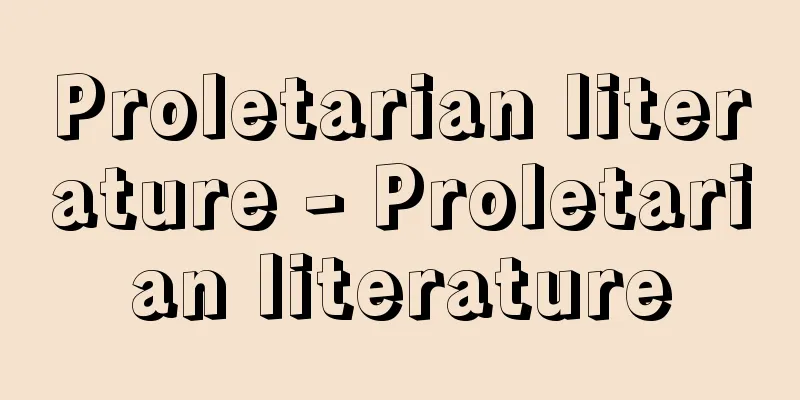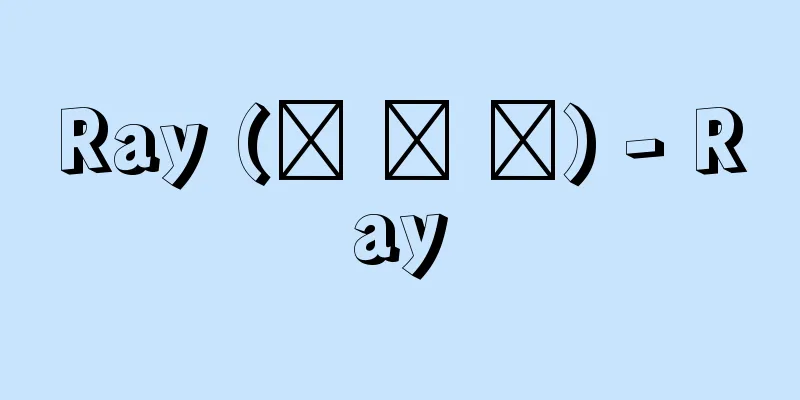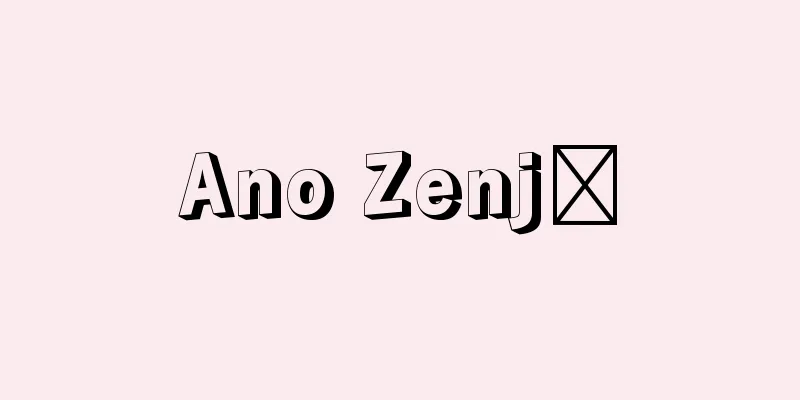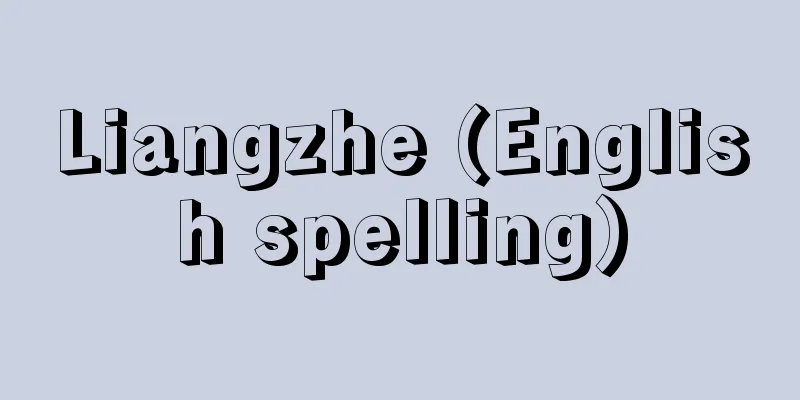Proletarian literature - Proletarian literature

|
This refers to literature based on the class consciousness and demands of the working class, which arose from the internal contradictions of modern capitalism. Marx, Engels and others began discussing this concept theoretically early on, but it was only after the success of the Russian Revolution in 1917 and the subsequent formation of Comintern (1919) that it began to gain popularity worldwide. [Norio Okubo] RussiaFirst, in Russia, the most significant change brought about by the revolution was the remarkable rise of proletarian literature. To summarize, during the "War Communist Period" (1917-21), the central organization of the proletarian cultural movement was Proletkrit (Proletarian Cultural Association), and the proletarian literature movement was born as part of the Proletkrit movement. The purpose of Proletkrit was to create a new spiritual culture for the proletariat and to make the proletariat the leading class in the ideological realm as well, and it defined collectivism as the principle of this class culture, but revolutionary romantic poetry and sensational poetry were mainstream during this period, and the first proletarian writers' association in human history, "Kuznitsa" (Blacksmiths), was organized. The following "New Economic Policy" period (1921-29) was a revival of Soviet literature, when realistic and objective realism was valued, and proletarian novels such as Libedinsky's One Week and Serafimovich's Flow of Iron, which were based on the theme of the civil war, succeeded in highlighting the collective power behind the actions of individuals. In 1925, the All-Russian Union of Proletarian Writers (abbreviated as WAP) was founded. The union demanded the consistency of proletarian ideology with high artistic quality, and it advocated the portrayal of "living people." Fadeev's Annihilation (1927) was a groundbreaking work that supported this argument, and was noted for its focus on individual psychology. The following year, in 1928, the 1st All-Union Proletarian Writers Conference was held, which dissolved the now hollow WAP, and established its own writers' union in each federation. On top of that, a unifying body for the unions, the Union of Russian Proletarian Writers (RUP), began to stand out as a central force in the all-union. It advocated psychological realism as a creative method. However, in the "period of socialist construction" (after 1929), psychological realism as a creative method of "rap" was criticized, a resolution was made to "Bolshevikize" the proletarian literary movement, and a hybrid form of realism and romanticism appeared. Then, in 1934, a single Union of Soviet Writers was formed, and socialist realism was decided as the basic method of Soviet art and literature. The earliest manifestation of this was Gorky's Forty Years (1925-36, original title The Life of Klim Samgin), followed by other masterpieces such as Sholokhov's Quiet Don (1928-40), which dealt with the civil war in the early days of the revolution, the same author's Virgin Open Soil (1932-60), which dealt with the theme of agricultural collectivization, and Ostrovsky's How the Steel Was Tempered (1932-34), a work by a new generation writer, but socialist realism became a dogma under the bureaucratization of the Writers' Union and the fear of purges. After World War II, Ehrenburg's The Thaw appeared in 1954, anticipating the criticism of Stalin (1956), and the title "Thaw" became a globally common noun describing the liberalization of the Soviet Union. However, political intervention continued, starting with Pasternak's expulsion from the Writers' Union in the 1958 Nobel Prize scandal, and followed by Solzhenitsyn's exile (1974), creating a situation in which "Soviet literature" at home and "contemporary Russian literature" abroad coexisted.But the Gorbachev administration's "glasnost (openness)" in 1985 and the subsequent collapse of the Soviet Union can be said to have destroyed the very basis for the existence of proletarian literature itself. [Norio Okubo] AmericaOn the other hand, America was far removed from the exhaustion that followed World War I and enjoyed unprecedented prosperity throughout its history. However, after the Great Depression that began with the "Black Friday" crash on the New York Stock Exchange in 1929, the word "radical" became synonymous with intellectuals. In the 1930s, social issues came into sharp focus, proletarian literature became popular, and left-wing ideology came to dominate the literary world for a time. To give one example, in the 1932 presidential election, the Communist Party of America nominated William Z. Forster as its candidate, and an organization of literary figures was quickly formed to support and back him. The writers who signed the letter were a surprisingly wide-ranging group, ranging from Sherwood Anderson and Dos Passos to Caldwell, the black Langston Hughes, and mid-level critics of the time such as Edmund Wilson, Malcolm Cowley, and Kenneth Burke. Alfred Kesin looked back on that time in his history of modern American literature entitled On Homeland Soil, stating, "In a country where 16 million people were unemployed and one million were on strike, it seemed to me that there could be no salvation other than a socialist government, and at the time I felt that being a socialist was a moral duty." However, the ideological strife and turmoil within the American left at the time made proletarian literature barren, and many of the best works were written by writers who focused on the problems of the times from a position somewhat removed from the political struggle. [Norio Okubo] EnglandIn 1932, when the Great Depression that began in America began to have a serious impact on Britain, a collection of poems by young poets, "New Signatures," was published, and the following year, "The New Country," which included prose in addition to poetry, was published, edited by Michael Roberts, just like the former. The contributors were young people from the middle class, but the latter was much more strongly left-wing, which may have meant that a group of young writers with a new tendency had appeared in Britain. In the 1930s, a collection of left-wing essays, "Minds in Chains: Socialism and the Cultural Revolution," edited by Day Lewis, was published, and when the Spanish Civil War broke out in 1936, various actions were taken to support the republican government, with Auden, Spender, MacNeice and others going to Spain, Orwell taking part in the fighting directly, and many young writers devoting their lives to anti-fascism. In his 26 stanzas of four lines each, "Spain" (1937), Auden sang of the hopes for the future of people who were trying to create history by saving Spain, while Day Lewis wrote the war epic "The Navarre" (1938), praising the brave battle of the Popular Front's trawler, the Navarre. [Norio Okubo] FranceIn France, Henri Barbusse, author of Inferno, which also had a great influence on Japan, converted from humanism to communism after his experiences in World War I, while Malraux, the active nihilist of The Conquerors (1928), was seen playing an active role as a republican pilot in the Spanish Civil War. When World War II began, he joined a tank corps in the regular army and was captured by the Germans, but managed to escape. Later, he joined the resistance movement and was captured again, but was rescued and promoted to brigade commander in the Alsace-Lorraine army, where he apparently met General de Gaulle. Meanwhile, Aragon, Éluard, and Breton joined the Communist Party in 1927, seeking to reconcile political revolution with the personal and artistic rebellion advocated by Surrealism. Breton soon left the party in his pursuit of absolute freedom, but Aragon, together with his friend Éluard, grew more convinced of Communism throughout the rise of Fascism and the People's War, and wrote the social novel series Les Reales (1934-44) and Les Communists (1949-51). [Norio Okubo] JapanThis refers to class-based, revolutionary literature that developed rapidly with the influence of Europe after World War I and the Russian Revolution, and the rise of socialist and revolutionary sentiment in Japan. Works such as Miyajima Masukeo's "The Miner" (1916), Miyaji Karoku's "The Wanderer Tomizo" (1920), and Maeda Kouichirou's "Third-Class Passenger" (1921) are representative works from the early days of proletarian literature. Osugi Sakae's "New Art for a New World" (1917) clearly indicated the direction of proletarian literature and was a pioneering problem-raising work. The claims of proletarian literature became a major driving force in the times after Komaki Oumi and others founded The Sower in 1921 (Taisho 10), bringing together socialist intellectuals and writers to launch a movement linked to the liberation movement of the working class. During this period, theory preceded actual writing, and a succession of works appeared, including Miyajima Sukeo's Claims of Labor Literature, Hirabayashi Hatsunosuke's Literature of the Fourth Estate and The Literary Movement and the Labor Movement, and Aono Suekichi's Class Struggle and the Art Movement. After that, the socialist movement suffered a devastating blow from the violent repression that followed the Great Kanto Earthquake of 1923, which saw the murders of Osugi Sakae, Hirasawa Keishichi, and others. The publication of The Sower was also suspended, and proletarian literature was in a total slump for a time, but the launch of the Literary Front (1924) marked a new period of growth. The representative writer of this period was Hayama Yoshiki, whose novel works such as People Living in the Sea, Prostitute, and Letters in a Cement Barrel shocked the established literary world with their fresh content and style. Other writers who emerged in succession included Kuroshima Denji, Satomura Kinzo, Hirabayashi Taiko, and Hayashi Fusao, all of whom achieved great success in terms of creative writing. During this time, the Japan Proletarian Literary Federation (Pro-ren) was formed in December 1925, and Bungei Sensen became its organ. The following December, Pro-ren was reorganized to become the Japan Proletarian Arts Federation (Pro-gei). In this way, proletarian literature developed into an organized literary movement, but this also marked the beginning of the division and conflict within literary organizations. In 1927 (Showa 2), Progei split up to form the Labor-Peasant Artists League (Rogei), which in turn split to form the Avant-Garde Arts League (Zengei), ushering in an era of a three-party system of Progei, Rogei, and Zengei. However, in March 1928, immediately after the so-called March 15 crackdown, Progei and Zengei, which supported the Japanese Communist Party, merged to form the All-Japan Proletarian Arts League (NAP), which launched its journal, Senki. NAP was later reorganized into the All-Japan Council of Proletarian Arts Organizations, and in February 1929, the Japan Proletarian Writers League (NARP) was launched as one of its constituent organizations. Thus began an era of conflict between the Bungei Sensen faction, which supported the social democratic labor-farmer faction politically and was made up of Aono Tokiyoshi, Maeda Kawahara Koichiro, Hayama Yoshiki, Kaneko Yobun, Hirabayashi Taiko, and Satomura Kinzo, and used the Bungei Sensen magazine as its official journal. During this period, Kurahara Korehito played a leading theoretical role at NAPF, whose official journal was "Senki," and a succession of new writers appeared, including Kobayashi Takiji, author of "March 15, 1928" and "The Crab Cannery Ship," Tokunaga Sunao, author of "A Town Without the Sun," Nakano Shigeharu, Kataoka Teppei, Murayama Tomoyoshi, Fujimori Seikichi, Tateno Nobuyuki, and Hashimoto Eikichi, ushering in the heyday of proletarian literature and demonstrating a force that overwhelmed the established literary world. However, leading members were arrested one after another, almost every issue of the organization's journal was banned, and the repression intensified, and after the Manchurian Incident in 1931, the tendency towards fascism and reaction became even stronger. In response to this, Kurahara Tadahito advocated the establishment of communist art in "The Mission of NAPF Artists" and called for NAPF artists to become communists. In November 1931, NAPF was reorganized as the Japan Proletarian Cultural League (KOPP), and the organization's journal "Proletarian Culture" was launched, while the Writers' League's journal became "Proletarian Literature." However, the repression became even more severe, leading members were arrested one after another, and the possibility of legal activity was taken away, causing greater unrest among the league's members. Kobayashi Takiji and Miyamoto Kenji went underground to lead the movement and tried to overcome right-wing tendencies, but when Kobayashi was captured and killed in February 1958, unrest intensified, and Miyamoto was subsequently arrested as well, leading to the final dissolution of the Writers' League in February 1959. After that, former members of the League aimed to create literature free from the shackles of politicalism through coterie magazines such as Literary Criticism, Bunka Shudan, and Bungakukai, which began to be published around the time of the dissolution, and raised the flag of "Literary Revival," but were ultimately swept away by the waves of war. The postwar democratic literary movement aimed to inherit and develop this movement. [Izu Toshihiko] "An Introduction to Soviet Literature" by Okazawa Hidetora (1947, Tokyodo)" ▽ "History of Proletarian Literature, Volumes 1 and 2, by Yamada Seizaburo (1954, Rironsha)" ▽ "Autobiographical Literary History" by Shikaji Wataru (1959, San'ichi Shobo)" ▽ "Lessons on the History of English and American Literature 11: The Twentieth Century II, edited by Fukuhara Rintaro and Nishikawa Masami (1961, Kenkyusha Publishing)" ▽ "Compendium of Japanese Proletarian Literature, all 8 volumes (1969, San'ichi Shobo)" ▽ "From the Flow of the Literary Movement" by Hirano Ken (1969, Chikuma Shobo)" ▽ "History of American Literature" by Saeki Shoichi (1969, Chikuma Shobo)" ▽ "Proletarian Literature and Its Era" by Kurihara Yukio (1971, Heibonsha)" ▽ "History of French Literature" by Suzuki Rikiei (1971, Meiji Shoin)" ▽ "History of Modern Literature, Volume 2" by Odagiri Hideo (1975, Shueisha)" ▽ "Narrative History of Modern Literature, The 1920s" by Okubo Norio (1984, Sorinsha)" ▽ "Collection of Japanese Proletarian Literature, all 41 volumes (1984-88, Shin Nihon Shuppansha)" ▽ "Guide to Proletarian Literature through Roundtable Discussions" by Izu Toshihiko et al. (1990, Shin Nihon Shuppansha)" ▽ "The Proletarian Literature Movement" by Yuchi Asao (1991, Banseisha) [References] | | |Source: Shogakukan Encyclopedia Nipponica About Encyclopedia Nipponica Information | Legend |
|
近代資本主義の内面的矛盾が生んだ、労働者階級の階級的自覚と要求に立脚した文学のこと。理論的には早く、マルクス、エンゲルスらによって論じられていたが、それが世界的同時性において多発化したのは、1917年のロシア革命の成功と、それに続くコミンテルンの結成(1919)以後である。 [大久保典夫] ロシアまず、ロシアだが、革命がもたらしたもっとも重大な変化がプロレタリア文学の目覚ましい勃興(ぼっこう)だろう。概略すれば、「戦時共産期」(1917~21)、プロレタリア文化運動の中心機関になったのがプロレトクリト(プロレタリア文化協会)で、プロレタリア文学運動は、プロレトクリトの運動の一部として生まれた。プロレトクリトの目的は、プロレタリア階級の新精神文化を創造し、プロレタリアートをイデオロギーの領域においても指導階級たらしめることにあり、その階級文化の原則を集団主義と規定したが、この時期は革命的浪漫(ろうまん)詩と煽情(せんじょう)詩が主流で、人類最初のプロレタリア作家団体「クーズニツア」(鍛冶(かじ)屋)が組織される。続く「新経済政策期」(1921~29)は、ソビエト文学の復興期で、現実的・客観的なリアリズムが尊重され、国内戦を基本テーマにしたリベジンスキーの『一週間』やセラフィモービチの『鉄の流れ』などのプロレタリア小説が、個人の行為を透かしてその背後に集団の渾然(こんぜん)たる力を浮かび上がらせるのに成功する。そして1925年「全ロシア・プロレタリア作家協会」(略称ワップ)が成立。プロレタリア・イデオロギーと高度の芸術性の一致が要求され、「生きた人間」を描くことが主張される。この主張を裏づけた画期的作品として、ファデーエフの『壊滅』(1927)が現れ、個人の心理により多くの注意を集中している点が注目された。翌28年「第1回全連邦プロレタリア作家大会」が開催され、形骸(けいがい)化した「ワップ」を解消、各連邦ごとに独自の作家同盟を置き、その上に各同盟の統一機関「ブォアップ」をつくったが、全連邦の中心的勢力としてロシア・プロレタリア作家協会(ラップ)の活躍が目だつようになる。創作方法として心理主義的リアリズムを提唱した。 しかし、「社会主義建設期」(1929以降)に入ると、「ラップ」の創作方法としての心理主義的リアリズムが批判され、プロレタリア文学運動の「ボリシェビキ」化が決議され、リアリズムとロマンチシズムの混合形態が現れる。続いて1934年、単一のソビエト作家同盟が成立し、社会主義的リアリズムをソビエト芸術文学の基本的方法と決めるに至る。そのもっとも早い現れがゴーリキーの『四十年』(1925~36、原題『クリム・サムギンの生涯』)で、以後、革命初期の国内戦を扱ったショーロホフの『静かなドン』(1928~40)や、農業集団化をテーマとした同じ作者の『開かれた処女地』(1932~60)、新世代のオストロフスキーの『鋼鉄は如何(いか)に鍛えられたか』(1932~34)などの大作が現れたが、作家同盟の官僚機構化と粛清の恐怖のもとで社会主義的リアリズムはドグマ化した。第二次世界大戦を経て、54年、スターリン批判(56年)を先取りしたエレンブルグの『雪どけ』が現れ、表題の「雪どけ」はソ連の自由化を表す世界的な普通名詞となる。しかし、58年のノーベル賞事件でのパステルナークの作家同盟除名に始まり、ソルジェニツィンの国外追放(74年)など、政治の介入はあとを断たず、国内の「ソビエト文学」と国外の「現代ロシア文学」が並存する状況が生まれたが、85年のゴルバチョフ政権による「グラスノスチ(情報公開)」とそれに続くソ連の崩壊は、プロレタリア文学そのものの存在基盤を消滅させたといえよう。 [大久保典夫] アメリカ一方、アメリカは第一次世界大戦後の疲弊から縁遠く、一貫して未曽有(みぞう)の繁栄を享受したが、1929年のニューヨーク株式取引所の「暗黒の金曜日」に始まる大恐慌以後、「ラジカル」(急進派)ということばが知識人の同意語となる。30年代に入ると、社会問題が大きくクローズアップされ、プロレタリア文学が盛んとなり、左翼イデオロギーが一時文学の世界を支配するようになる。一例をあげれば、32年の大統領選挙戦に、アメリカ共産党はウィリアム・Z・フォースターを候補として出馬させたが、彼を支持し後援する文学者の組織がたちまちつくられた。これに署名した作家は意外に幅の広い顔ぶれで、シャーウッド・アンダーソンやドス・パソスから、コールドウェルや黒人のラングストン・ヒューズその他、エドモンド・ウィルソン、マルカム・カウリー、ケネス・バークら当時の中堅批評家まで入っていたという。アルフレッド・ケージンは、『祖国の土の上で』と題した現代アメリカ文学史で当時を回顧して、「1600万の人間が失業し、100万人がストライキをしている国では、社会主義政権以外に救いの道があろうとは思われず、当時の僕にとって、社会主義者たることは、道義的な責務と感ぜられていた」と述懐している。しかし、当時のアメリカの左翼内部のイデオロギー的抗争と紛糾はプロレタリア文学を不毛とし、むしろ政治闘争から多少とも離れたところで時代の問題を凝視していた作家たちに優れたものが多い。 [大久保典夫] イギリスイギリスでは、アメリカに端を発した世界恐慌が深刻な影響を与え始めた1932年に、若い詩人たちによる詩華集『新署名』が出版され、翌年、詩のほかに散文をも加えた『新しい国』が、前者と同じくマイケル・ロバーツ編で出る。寄稿者は中産階級出身の若者たちだが、後者のほうがはるかに強く左翼的で、これらはイギリスに、新しい傾向をもつ若い一群の作家が登場したことを意味していよう。30年代には、デー・ルイス編の左翼的論文集『鎖につながれた精神――社会主義と文化革命』が出版されたし、また、36年にスペイン内乱が勃発(ぼっぱつ)すると、共和政府を援助する種々の行動をおこし、オーデン、スペンダー、マクニースたちもスペインに赴き、オーウェルは直接戦闘に参加し、若い作家たちの多くがその生命を反ファシズムのために捧(ささ)げた。オーデンは、4行ずつ26節からなる『スペイン』(1937)で、スペインを救うことによって歴史を創(つく)ろうとする人々の未来への希望を歌い、デー・ルイスは、人民戦線側のトロール漁船ナバラ号の勇敢な戦いをたたえた戦争叙事詩『ナバラ号』(1938)を書く。 [大久保典夫] フランスフランスでは、日本にも大きな影響を与えた『地獄』の作者アンリ・バルビュスが、第一次世界大戦の体験を経てヒューマニストからさらにコミュニスムに帰依(きえ)し、『征服者』(1928)の行動的ニヒリスト、マルローが、スペイン戦争では共和派の飛行隊長として活躍しているのが目につく。第二次世界大戦が始まると、彼は正規軍の戦車隊に投じ、ドイツ軍の捕虜になるが脱出。のち、抵抗運動に参加してふたたび捕らえられるが、救出されてアルザス・ロレーヌ軍の旅団長に推され、ドゴール将軍と出会ったらしい。一方、アラゴン、エリュアール、ブルトンらは、1927年、政治革命とシュルレアリスムの主張する個人的・芸術的反抗との一致を求めて共産党に入党。ブルトンは、まもなく絶対的自由への希求から脱党するが、アラゴンは僚友エリュアールとともに、ファシズムの台頭と人民戦争時代を通してコミュニスムへの確信を強め、社会小説の連作『現実世界』(1934~44)や『レ・コミュニスト』(1949~51)を書いた。 [大久保典夫] 日本第一次世界大戦、ロシア革命後のヨーロッパの影響と国内の社会主義的、革命的な気運の高揚に伴って、急速に発展した階級的革命的文学をいう。宮嶋資夫(みやじますけお)の『坑夫』(1916)や宮地嘉六(かろく)の『放浪者富蔵(ほうろうしゃとみぞう)』(1920)、前田河広一郎(まえだこうひろいちろう)の『三等船客』(1921)などはプロレタリア文学の萌芽(ほうが)期を代表する作品である。大杉栄(さかえ)の『新しき世界の為(ため)の新しき芸術』(1917)はプロレタリア文学の方向をはっきり示し、先駆的な問題提起となった。 プロレタリア文学の主張が時代を動かす大きな力となったのは、1921年(大正10)小牧近江(こまきおうみ)らによって『種蒔(ま)く人』が創刊され、社会主義的な知識人・文学者が結集して、労働者階級の解放運動と結び付いた運動が展開されるようになってからである。この時期は理論が実作に先行し、宮嶋資夫『労働文学の主張』、平林初之輔(はつのすけ)『第四階級の文学』『文芸運動と労働運動』、青野季吉(すえきち)『階級闘争と芸術運動』などが相次いで現れた。その後、関東大震災(1923)に際して大杉栄、平沢計七(けいしち)らが殺されたのをはじめとして、激しい弾圧によって社会主義運動は壊滅的打撃を受けた。『種蒔く人』も廃刊となり、プロレタリア文学は一時まったく沈滞したが、『文芸戦線』創刊(1924)を契機に新たな高揚期を迎えた。この時期の代表的作家は葉山嘉樹(よしき)で、『海に生くる人々』をはじめ『淫売婦(いんばいふ)』『セメント樽(だる)の中の手紙』などは新鮮な内容と文体で、既成文壇にも衝撃を与えた。このほか黒島伝治(でんじ)、里村欣三(きんぞう)、平林たい子、林房雄(ふさお)などが相次いで現れ、創作の面でも大きな成果をあげた。この間、1925年12月に日本プロレタリア文芸連盟(プロ連)が結成され、『文芸戦線』はその機関誌となった。プロ連は翌年12月に改組されて日本プロレタリア芸術連盟(プロ芸)となった。 こうして、プロレタリア文学は組織的な文学運動として発展させられることになったが、それはまた、文学組織の分裂抗争の始まりでもあった。1927年(昭和2)プロ芸は分裂し、労農芸術家連盟(労芸)が成立、さらに労芸が分裂して前衛芸術連盟(前芸)が成立、プロ芸、労芸、前芸の三派鼎立(ていりつ)時代が出現した。しかし、28年3月、いわゆる三・一五の大弾圧の直後に、日本共産党を支持するプロ芸と前芸の合同が実現して、全日本無産者芸術連盟(ナップ)が結成され、機関誌『戦旗』を創刊した。その後ナップは全日本無産者芸術団体協議会に改組され、その構成団体の一つとして29年2月、日本プロレタリア作家同盟(ナルプ)が発足した。こうして、『文芸戦線』を機関誌とし、政治的には社会民主主義的な労農派を支持する、青野季吉、前田河広一郎、葉山嘉樹、金子洋文(ようぶん)、平林たい子、里村欣三らの文戦派と、ナップ派との対立時代が始まった。この時期、『戦旗』を機関誌とするナップは蔵原惟人(くらはらこれひと)が理論面で指導的役割を果たし、『一九二八年三月十五日』『蟹工船(かにこうせん)』の小林多喜二(たきじ)、『太陽のない街』の徳永直(すなお)をはじめ、中野重治(しげはる)、片岡鉄兵(てっぺい)、村山知義(ともよし)、藤森成吉(せいきち)、立野信之(たてののぶゆき)、橋本英吉(えいきち)など、続々と新しい作家が登場してプロレタリア文学の全盛期を迎え、既成文壇を圧倒する勢いを示した。 しかし指導的メンバーが相次いで検挙され、機関誌もほとんど毎号発禁となるなど弾圧が激化し、1931年の満州事変以後はファッショ化、反動化の傾向が一段と強まった。これに対して蔵原惟人は『ナップ芸術家の任務』で共産主義芸術の確立を提唱し、ナップ芸術家の共産主義化を求めた。31年11月、ナップは日本プロレタリア文化連盟(コップ)に改組され、機関誌『プロレタリア文化』を創刊し、作家同盟の機関誌は『プロレタリア文学』となった。しかし、弾圧はいっそう激化し、指導的メンバーは根こそぎ検挙され、合法活動の可能性を奪われて、同盟員の動揺は強まった。小林多喜二、宮本顕治(けんじ)は地下に潜って運動を指導し、右翼的傾向の克服に努めたが、33年2月、小林が捕らえられて殺されるに及んで、動揺はいっそう強まり、その後、宮本も検挙されて、34年2月、作家同盟はついに解散した。その後、旧同盟員たちは、解散前後から刊行され始めた『文学評論』『文化集団』、さらには『文学界』などの同人雑誌によって、政治主義の呪縛(じゅばく)から解放された文学の創造を目ざし、「文芸復興」の旗を掲げたりしたが、結局、戦争の波に飲み込まれていった。戦後の民主主義文学運動は、この運動を受け継ぎ、発展させることを目ざしたものである。 [伊豆利彦] 『岡沢秀虎著『ソヴェート文学概論』(1947・東京堂)』▽『山田清三郎著『プロレタリア文学史』上下(1954・理論社)』▽『鹿地亘著『自伝的な文学史』(1959・三一書房)』▽『福原麟太郎・西川正身監修『英米文学史講座11 二十世紀Ⅱ』(1961・研究社出版)』▽『『日本プロレタリア文学大系』全8巻(1969・三一書房)』▽『平野謙著『文学運動の流れのなかから』(1969・筑摩書房)』▽『佐伯彰一著『アメリカ文学史』(1969・筑摩書房)』▽『栗原幸夫著『プロレタリア文学とその時代』(1971・平凡社)』▽『鈴木力衛著『フランス文学史』(1971・明治書院)』▽『小田切秀雄著『現代文学史 下』(1975・集英社)』▽『大久保典夫著『物語現代文学史 1920年代』(1984・創林社)』▽『『日本プロレタリア文学集』全41巻(1984~88・新日本出版社)』▽『伊豆利彦他著『座談によるプロレタリア文学案内』(1990・新日本出版社)』▽『湯地朝雄著『プロレタリア文学運動』(1991・晩声社)』 [参照項目] | | |出典 小学館 日本大百科全書(ニッポニカ)日本大百科全書(ニッポニカ)について 情報 | 凡例 |
<<: Proletkul't (English spelling)
>>: Proletariat (English spelling)
Recommend
Thread-wrapped sword fittings
…However, the scabbard coating and metal fittings...
Opium alkaloids
Also known as poppy alkaloids. A general term for...
Say - Like this
In ancient China, this was called the royal decree...
docta ignorantia (English spelling) doctaignorantia
… Pietism [Kanteru Ueda] [Modern and contemporary...
Masuda Pond - Masuda Pond
A pond built in Takaichi County, Yamato Province. ...
Baktria
...The capital was Balkh (anciently called Baktra...
Kuze [town] - habit
An old town in Maniwa County in the upper reaches ...
van Ostade, A.
...Furthermore, the cutthroat free competition to...
Velvet - Biroudo
It is also written as Tengasu and is called velve...
C1 Chemistry - C1 Chemistry
Due to the sudden rise in oil prices, there has be...
Burial Furnace - Umegamero
...In the early period, it became common to have ...
Myosin
It is one of the proteins that make up muscle and...
Antu - Antu
...The animistic worldview is strongly evident in...
Obaku Kiun
Date of birth and death unknown. A Zen monk from ...
Simeon I
864‐927 Prince of Bulgaria (reigned 893-913 or 918...









